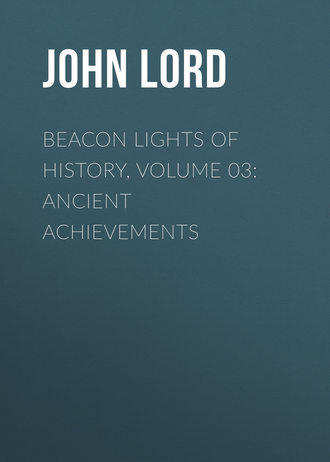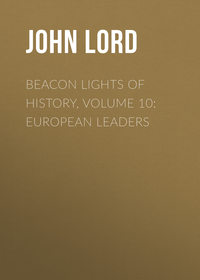 полная версия
полная версияBeacon Lights of History, Volume 03: Ancient Achievements
Immense research and learning have been expended by modern critics to show the state of scientific astronomy among the Greeks. I am amazed equally at the amount of research and its comparative worthlessness; for what addition to science can be made by an enumeration of the puerilities and errors of the Greeks, and how wasted and pedantic the learning which ransacks all antiquity to prove that the Greeks adopted this or that absurdity!1
The earliest historic name associated with astronomy in Greece was Thales, the founder of the Ionic school of philosophers. He is reported to have made a visit to Egypt, to have fixed the year at three hundred and sixty-five days, to have determined the course of the sun from solstice to solstice, and to have calculated eclipses. He attributed an eclipse of the moon to the interposition of the earth between the sun and moon, and an eclipse of the sun to the interposition of the moon between the sun and earth,–and thus taught the rotundity of the earth, sun, and moon. He also determined the ratio of the sun's diameter to its apparent orbit. As he first solved the problem of inscribing a right-angled triangle in a circle, he is the founder of geometrical science in Greece. He left, however, nothing to writing; hence all accounts of him are confused,–some doubting even if he made the discoveries attributed to him. His philosophical speculations, which science rejects,–such as that water is the principle of all things,–are irrelevant to a description of the progress of astronomy. That he was a great light no one questions, considering the ignorance with which he was surrounded.
Anaximander, who followed Thales in philosophy, held to puerile doctrines concerning the motions and nature of the stars, which it is useless to repeat. His addition to science, if he made any, was in treating the magnitudes and distances of the planets. He constructed geographical charts, and attempted to delineate the celestial sphere, and to measure time with a gnomon, or time-pillar, by the motion of its shadow upon a dial.2
Anaximenes of Miletus taught, like his predecessors, crude notions of the sun and stars, and speculated on the nature of the moon, but did nothing to advance his science on true grounds, except by the construction of sun-dials. The same may be said of Heraclitus, Xenophanes, Parmenides, and Anaxagoras: they were great men, but they gave to the world mere speculations, some of which are very puerile. They all held to the idea that the heavenly bodies revolved around the earth, and that the earth was a plain; but they explained eclipses, and supposed that the moon derived its light from the sun. Some of them knew the difference between the planets and the fixed stars. Anaxagoras scouted the notion that the sun was a god, and supposed it to be a mass of ignited stone,–for which he was called an atheist.
Socrates, who belonged to another school, avoided all barren speculations concerning the universe, and confined himself to human actions and interests. He looked even upon geometry in a very practical way, valuing it only so far as it could be made serviceable to land-measuring. As for the stars and planets, he supposed it was impossible to arrive at a true knowledge of them, and regarded speculations upon them as useless.
It must be admitted that the Greek astronomers, however barren were their general theories, laid the foundation of science. Pythagoras taught the obliquity of the ecliptic, probably learned in Egypt, and the identity of the morning and evening stars. It is supposed that he maintained that the sun was the centre of the universe, and that the earth revolved around it; but this he did not demonstrate, and his whole system was unscientific, assuming certain arbitrary principles, from which he reasoned deductively. "He assumed that fire is more worthy than earth; that the more worthy place must be given to the more worthy; that the extremity is more worthy than the intermediate parts,–and hence, as the centre is an extremity, the place of fire is at the centre of the universe, and that therefore the earth and other heavenly bodies move round the fiery centre." But this was no heliocentric system, since the sun moved, like the earth, in a circle around the central fire. This was merely the work of the imagination, utterly unscientific, though bold and original. Nor did this hypothesis gain credit, since it was the fixed opinion of philosophers that the earth was the centre of the universe, around which the sun, moon, and planets revolved. But the Pythagoreans were the first to teach that the motions of the sun, moon, and planets are circular and equable. Their idea that the celestial bodies emitted a sound, and were combined into a harmonious symphony, was exceedingly crude, however beautiful "The music of the spheres" belongs to poetry, as well as to the speculations of Plato.
Eudoxus, in the fifth century before Christ, contributed to science by making a descriptive map of the heavens, which was used as a manual of sidereal astronomy to the sixth century of our era.
The error of only one hundred and ninety days in the periodic time of Saturn shows that there had been for a long time close observations. Aristotle–whose comprehensive intellect, like that of Bacon, took in all forms of knowledge–condensed all that was known in his day into a treatise concerning the heavens. He regarded astronomy as more intimately connected with mathematics than any other branch of science. But even he did not soar far beyond the philosophers of his day, since he held to the immobility of the earth,–the grand error of the ancients. Some few speculators in science (like Heraclitus of Pontus, and Hicetas) conceived a motion of the earth itself upon its axis, so as to account for the apparent motion of the sun; but they also thought it was in the centre of the universe.
The introduction of the gnomon (time-pillar) and dial into Greece advanced astronomical knowledge, since they were used to determine the equinoxes and solstices, as well as parts of the day. Meton set up a sun-dial at Athens in the year 433 B.C., but the length of the hour varied with the time of the year, since the Greeks divided the day into twelve equal parts. Dials were common at Rome in the time of Plautus, 224 B.C.; but there was a difficulty in using them, since they failed at night and in cloudy weather, and could not be relied on. Hence the introduction of water-clocks instead.
Aristarchus is said to have combated (280 B.C.) the geocentric theory so generally received by philosophers, and to have promulgated the hypothesis "that the fixed stars and the sun are immovable; that the earth is carried round the sun in the circumference of a circle of which the sun is the centre; and that the sphere of the fixed stars, having the same centre as the sun, is of such magnitude that the orbit of the earth is to the distance of the fixed stars as the centre of the sphere of the fixed stars is to its surface." Aristarchus also, according to Plutarch, explained the apparent annual motion of the sun in the ecliptic by supposing the orbit of the earth to be inclined to its axis. There is no evidence that this great astronomer supported his heliocentric theory with any geometrical proof, although Plutarch maintains that he demonstrated it. This theory gave great offence, especially to the Stoics; and Cleanthes, the head of the school at that time, maintained that the author of such an impious doctrine should be punished. Aristarchus left a treatise "On the Magnitudes and Distances of the Sun and Moon;" and his methods to measure the apparent diameters of the sun and moon are considered theoretically sound by modern astronomers, but practically inexact owing to defective instruments. He estimated the diameter of the sun at the seven hundred and twentieth part of the circumference of the circle which it describes in its diurnal revolution, which is not far from the truth; but in this treatise he does not allude to his heliocentric theory.
Archimedes of Syracuse, born 287 B.C., is stated to have measured the distance of the sun, moon, and planets, and he constructed an orrery in which he exhibited their motions. But it was not in the Grecian colony of Syracuse, but of Alexandria, that the greatest light was shed on astronomical science. Here Aristarchus resided, and also Eratosthenes, who lived between the years 276 and 196 B.C. The latter was a native of Athens, but was invited by Ptolemy Euergetes to Alexandria, and placed at the head of the library. His great achievement was the determination of the circumference of the earth. This was done by measuring on the ground the distance between Syene, a city exactly under the tropic, and Alexandria, situated on the same meridian. The distance was found to be five thousand stadia. The meridional distance of the sun from the zenith of Alexandria he estimated to be 7° 12', or a fiftieth part of the circumference of the meridian. Hence the circumference of the earth was fixed at two hundred and fifty thousand stadia,–which is not very different from our modern computation. The circumference being known, the diameter of the earth was easily determined. The moderns have added nothing to this method. He also calculated the diameter of the sun to be twenty-seven times greater than that of the earth, and the distance of the sun from the earth to be eight hundred and four million stadia, and that of the moon seven hundred and eighty thousand stadia,–a close approximation to the truth.
Astronomical science received a great impulse from the school of Alexandria, the greatest light of which was Hipparchus, who flourished early in the second century before Christ. He laid the foundation of astronomy upon a scientific basis. "He determined," says Delambre, "the position of the stars by right ascensions and declinations, and was acquainted with the obliquity of the ecliptic. He determined the inequality of the sun and the place of its apogee, as well as its mean motion; the mean motion of the moon, of its nodes and apogee; the equation of the moon's centre, and the inclination of its orbit. He calculated eclipses of the moon, and used them for the correction of his lunar tables, and he had an approximate knowledge of parallax." His determination of the motions of the sun and moon, and his method of predicting eclipses evince great mathematical genius. But he combined with this determination a theory of epicycles and eccentrics which modern astronomy discards. It was however a great thing to conceive of the earth as a solid sphere, and to reduce the phenomena of the heavenly bodies to uniform motions in circular orbits. "That Hipparchus should have succeeded in the first great steps of the resolution of the heavenly bodies into circular motions is a circumstance," says Whewell, "which gives him one of the most distinguished places in the roll of great astronomers." But he did even more than this: he discovered that apparent motion of the fixed stars round the axis of the ecliptic, which is called the Precession of the Equinoxes,–one of the greatest discoveries in astronomy. He maintained that the precession was not greater than fifty-nine seconds, and not less than thirty-six seconds. Hipparchus also framed a catalogue of the stars, and determined their places with reference to the ecliptic by their latitudes and longitudes. Altogether he seems to have been one of the greatest geniuses of antiquity, and his works imply a prodigious amount of calculation.
Astronomy made no progress for three hundred years, although it was expounded by improved methods. Posidonius constructed an orrery, which exhibited the diurnal motions of the sun, moon, and five planets. Posidonius calculated the circumference of the earth to be two hundred and forty thousand stadia, by a different method from Eratosthenes. The barrenness of discovery from Hipparchus to Ptolemy,–the Alexandrian mathematician, astronomer, and geographer in the second century of the Christian era,–in spite of the patronage of the royal Ptolemies of Egypt, was owing to the want of instruments for the accurate measure of time (like our clocks), to the imperfection of astronomical tables, and to the want of telescopes. Hence the great Greek astronomers were unable to realize their theories. Their theories however were magnificent, and evinced great power of mathematical combination; but what could they do without that wondrous instrument by which the human eye indefinitely multiplies its power? Moreover, the ancients had no accurate almanacs, since the care of the calendar belonged not so much to the astronomers as to the priests, who tampered with the computation of time for sacerdotal objects. The calendars of different communities differed. Hence Julius Caesar rendered a great service to science by the reform of the Roman calendar, which was exclusively under the control of the college of pontiffs, or general religious overseers. The Roman year consisted of three hundred and fifty-five days; and in the time of Caesar the calendar was in great confusion, being ninety days in advance, so that January was an autumn month. He inserted the regular intercalary month of twenty-three days, and two additional ones of sixty-seven days. These, together with ninety days, were added to three hundred and sixty-five days, making a year of transition of four hundred and forty-five days, by which January was brought back to the first month in the year after the winter solstice; and to prevent the repetition of the error, he directed that in future the year should consist of three hundred and sixty-five and one-quarter days, which he effected by adding one day to the months of April, June, September, and November, and two days to the months of January, Sextilis, and December, making an addition of ten days to the old year of three hundred and fifty-five. And he provided for a uniform intercalation of one day in every fourth year, which accounted for the remaining quarter of a day.
Caesar was a student of astronomy, and always found time for its contemplation. He is said even to have written a treatise on the motion of the stars. He was assisted in his reform of the calendar by Sosigines, an Alexandrian astronomer. He took it out of the hands of the priests, and made it a matter of pure civil regulation. The year was defined by the sun, and not as before by the moon.
Thus the Romans were the first to bring the scientific knowledge of the Greeks into practical use; but while they measured the year with a great approximation to accuracy, they still used sun-dials and water-clocks to measure diurnal time. Yet even these were not constructed as they should have been. The hour-marks on the sun-dial were all made equal, instead of varying with the periods of the day,–so that the length of the hour varied with the length of the day. The illuminated interval was divided into twelve equal parts; so that if the sun rose at five A.M., and set at eight P.M., each hour was equal to eighty minutes. And this rude method of measurement of diurnal time remained in use till the sixth century. Clocks, with wheels and weights, were not invented till the twelfth century.
The last great light among the ancients in astronomical science was Ptolemy, who lived from 100 to 170 A.D., in Alexandria. He was acquainted with the writings of all the previous astronomers, but accepted Hipparchus as his guide. He held that the heaven is spherical and revolves upon its axis; that the earth is a sphere, and is situated within the celestial sphere, and nearly at its centre; that it is a mere point in reference to the distance and magnitude of the fixed stars, and that it has no motion. He adopted the views of the ancient astronomers, who placed Saturn, Jupiter, and Mars next under the sphere of the fixed stars, then the sun above Venus and Mercury, and lastly the moon next to the earth. But he differed from Aristotle, who conceived that the earth revolves in an orbit around the centre of the planetary system, and turns upon its axis,–two ideas in common with the doctrines which Copernicus afterward unfolded. But even Ptolemy did not conceive the heliocentric theory,–the sun the centre of our system. Archimedes and Hipparchus both rejected this theory.
In regard to the practical value of the speculations of the ancient astronomers, it may be said that had they possessed clocks and telescopes, their scientific methods would have sufficed for all practical purposes. The greatness of modern discoveries lies in the great stretch of the perceptive powers, and the magnificent field they afford for sublime contemplation. "But," as Sir G. Cornewall Lewis remarks, "modern astronomy is a science of pure curiosity, and is directed exclusively to the extension of knowledge in a field which human interests can never enter. The periodic time of Uranus, the nature of Saturn's ring, and the occultation of Jupiter's satellites are as far removed from the concerns of mankind as the heliacal rising of Sirius, or the northern position of the Great Bear." This may seem to be a utilitarian view, with which those philosophers who have cultivated science for its own sake, finding in the same a sufficient reward, can have no sympathy.
The upshot of the scientific attainments of the ancients, in the magnificent realm of the heavenly bodies, would seem to be that they laid the foundation of all the definite knowledge which is useful to mankind; while in the field of abstract calculation they evinced reasoning and mathematical powers that have never been surpassed. Eratosthenes, Archimedes, and Hipparchus were geniuses worthy to be placed by the side of Kepler, Newton, and La Place, and all ages will reverence their efforts and their memory. It is truly surprising that with their imperfect instruments, and the absence of definite data, they reached a height so sublime and grand. They explained the doctrine of the sphere and the apparent motions of the planets, but they had no instruments capable of measuring angular distances. The ingenious epicycles of Ptolemy prepared the way for the elliptic orbits and laws of Kepler, which in turn conducted Newton to the discovery of the law of gravitation,–the grandest scientific discovery in the annals of our race.
Closely connected with astronomical science was geometry, which was first taught in Egypt,–the nurse and cradle of ancient wisdom. It arose from the necessity of adjusting the landmarks disturbed by the inundations of the Nile. There is hardly any trace of geometry among the Hebrews. Among the Hindus there are some works on this science, of great antiquity. Their mathematicians knew the rule for finding the area of a triangle from its sides, and also the celebrated proposition concerning the squares on the sides of the right-angled triangle. The Chinese, it is said, also knew this proposition before it was known to the Greeks, among whom it was first propounded by Thales. He applied a circle to the measurement of angles. Anaximander made geographical charts, which required considerable geometrical knowledge. Anaxagoras employed himself in prison in attempting to square the circle. Thales, as has been said, discovered the important theorem that in a right-angled triangle the squares on the sides containing the right angle are together equal to the square on the opposite side of it. Pythagoras discovered that of all figures having the same boundary, the circle among plane figures and the sphere among solids are the most capacious. Hippocrates treated of the duplication of the cube, and wrote elements of geometry, and knew that the area of a circle was equal to a triangle whose base is equal to its circumference and altitude equal to its radius. The disciples of Plato invented conic sections, and discovered the geometrical foci.
It was however reserved for Euclid to make his name almost synonymous with geometry. He was born 323 B.C., and belonged to the Platonic sect, which ever attached great importance to mathematics. His "Elements" are still in use, as nearly perfect as any human production can be. They consist of thirteen books. The first four are on plane geometry; the fifth is on the theory of proportion, and applies to magnitude in general; the seventh, eighth, and ninth are on arithmetic; the tenth on the arithmetical characteristics of the division of a straight line; the eleventh and twelfth on the elements of solid geometry; the thirteenth on the regular solids. These "Elements" soon became the universal study of geometers throughout the civilized world; they were translated into the Arabic, and through the Arabians were made known to mediaeval Europe. There can be no doubt that this work is one of the highest triumphs of human genius, and it has been valued more than any single monument of antiquity; it is still a text-book, in various English translations, in all our schools. Euclid also wrote various other works, showing great mathematical talent.
Perhaps a greater even than Euclid was Archimedes, born 287 B.C. He wrote on the sphere and cylinder, terminating in the discovery that the solidity and surface of a sphere are two thirds respectively of the solidity and surface of the circumscribing cylinder. He also wrote on conoids and spheroids. "The properties of the spiral and the quadrature of the parabola were added to ancient geometry by Archimedes, the last being a great step in the progress of the science, since it was the first curvilineal space legitimately squared." Modern mathematicians may not have the patience to go through his investigations, since the conclusions he arrived at may now be reached by shorter methods; but the great conclusions of the old geometers were reached by only prodigious mathematical power. Archimedes is popularly better known as the inventor of engines of war and of various ingenious machines than as a mathematician, great as were his attainments in this direction. His theory of the lever was the foundation of statics till the discovery of the composition of forces in the time of Newton, and no essential addition was made to the principles of the equilibrium of fluids and floating bodies till the time of Stevin, in 1608. Archimedes detected the mixture of silver in a crown of gold which his patron, Hiero of Syracuse, ordered to be made; and he invented a water-screw for pumping water out of the hold of a great ship which he had built. He contrived also the combination of pulleys, and he constructed an orrery to represent the movement of the heavenly bodies. He had an extraordinary inventive genius for discovering new provinces of inquiry and new points of view for old and familiar objects. Like Newton, he had a habit of abstraction from outward things, and would forget to take his meals. He was killed by Roman soldiers when Syracuse was taken; and the Sicilians so soon forgot his greatness that in the time of Cicero they did not know where his tomb was.
Eratosthenes was another of the famous geometers of antiquity, and did much to improve geometrical analysis. He was also a philosopher and geographer. He gave a solution of the problem of the duplication of the cube, and applied his geometrical knowledge to the measurement of the magnitude of the earth,–being one of the first who brought mathematical methods to the aid of astronomy, which in our day is almost exclusively the province of the mathematician.
Apollonius of Perga, probably about forty years younger than Archimedes, and his equal in mathematical genius, was the most fertile and profound writer among the ancients who treated of geometry. He was called the Great Geometer. His most important work is a treatise on conic sections, which was regarded with unbounded admiration by contemporaries, and in some respects is unsurpassed by any thing produced by modern mathematicians. He however made use of the labors of his predecessors, so that it is difficult to tell how far he is original. But all men of science must necessarily be indebted to those who have preceded them. Even Homer, in the field of poetry, made use of the bards who had sung for a thousand years before him; and in the realms of philosophy the great men of all ages have built up new systems on the foundations which others have established. If Plato or Aristotle had been contemporaries with Thales, would they have matured so wonderful a system of dialectics? Yet if Thales had been contemporaneous with Plato, he might have added to the great Athenian's sublime science even more than did Aristotle. So of the great mathematicians of antiquity; they were all wonderful men, and worthy to be classed with the Newtons and Keplers of our times. Considering their means and the state of science, they made as great though not as fortunate discoveries,–discoveries which show patience, genius, and power of calculation. Apollonius was one of these,–one of the master intellects of antiquity, like Euclid and Archimedes; one of the master intellects of all ages, like Newton himself. I might mention the subjects of his various works, but they would not be understood except by those familiar with mathematics.









